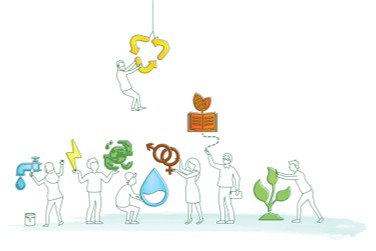Enterprise Profile
This type of enterprise offers products, specifically non-durable products, to end consumers as a B2C business. Since the business requires a large customer base, it operates in an urban environment, where the population is dense, and the average income level allows selling at cost-covering or profit-generating prices.
Business Model Features
This type of enterprise focuses on offering standardized and scalable consumer goods such as soap, domestic water filters, or bottled water. While the production of products involves some form of technology to have a competitive edge, the products themselves are normal, daily staples that have multiple alternatives, indicating that differentiating the product towards the consumers is of importance. Cooperation with retailers or innovative logistical solutions are key to enable the business to sell the products to customers at scale.
Context and Environment
Enterprises in this typology focus on selling in predominantly in urban areas. They usually target higher to middle income customers in the cities, where there is a larger population and higher willingness to pay for the product. Marginalized and BoP communities are less likely to buy the product due to the higher price compared to similar products in the market.
Impact Potential
This type of enterprise offers products that are related to water use of the end consumer, but the focus is more on the product itself than the consumer. In terms of impact, this means that the enterprise can create water-related impact depending on the product, but there is more potential to create other types of impact throughout the production process and product lifecycle – e.g., using organic waste as material, using biodegradable packaging, or engaging women, youth, or marginalized communities in the value creation process of business. While the impact potential might not be as deep as serving the BoP community, it can be broad and across various SDGs, depending on the scale of the enterprise.
Potentially relevant SDG Targets
Water-related impact
SDG 6.1 By 2030, achieve universal and equitable access to safe and affordable drinking water for all.
SDG 6.2 By 2030, achieve access to adequate and equitable sanitation and hygiene for all and end open defecation, paying special attention to the needs of women and girls and those in vulnerable situations.
SDG 6.3 By 2030, improve water quality by reducing pollution, eliminating dumping and minimizing release of hazardous chemicals and materials, halving the proportion of untreated wastewater and substantially increasing recycling and safe reuse globally.
Environmental impact
SDG 12.2 By 2030, achieve the sustainable management and efficient use of natural resources
SDG 12.3 By 2030, halve per capita global food waste at the retail and consumer levels and reduce food losses along production and supply chains, including post-harvest losses
SDG 12.5 By 2030, substantially reduce waste generation through prevention, reduction, recycling and reuse.
SDG 12.8 By 2030, ensure that people everywhere have the relevant information and awareness for sustainable development and lifestyles in harmony with nature.
Social impact
SDG 5.5 Ensure women’s full and effective participation and equal opportunities for leadership at all levels of decision-making in political, economic and public life
SDG 8.5 By 2030, achieve full and productive employment and decent work for all women and men, including for young people and persons with disabilities, and equal pay for work of equal value.
SDG 8.6 By 2020, substantially reduce the proportion of youth not in employment, education or training
SDG 8.8 Protect labour rights and promote safe and secure working environments for all workers, including migrant workers, in particular women migrants, and those in precarious employment
Team and Experience
The enterprise has been working on its business model for at least a year, and is backed by a strong team with relevant knowledge (at least 4+ years professional experience) in finance and marketing/sales, which is particularly important for B2C businesses. Since the products are not based on cutting-edge technology but rather existing ones, the presence of technological and production expertise can compensate for the lack of R&D.
Financial Profile
One of the main advantages of the enterprise is its cost structure. Not only does it have low capital expenditure requirements, but it also lowers its production cost (or at least has the potential to do so) by reusing waste as material or outsourcing (parts) of the production. This allows the company to reach its break-even point early in the process.
Due to its financial aspect and the scalability of the product, the enterprise has the potential to attract commercial debt and equity investors.
What are your Financing Options?
Given the commercial viability of the enterprise, it would be fitting to secure grants for incubation or acceleration, and the potential for impact will be perceived positively. Nevertheless, the depth of impact is likely not significant enough to attract donors who would be willing to provide grants or result-based financing based on impact, especially water-related ones.
Equity or alike (common stock, preferred equity, convertible note, SAFE)
The commercial viability of the enterprise is promising for receiving equity or alike, and is likely to provide it with the discipline to grow through market-based mechanisms (in comparison to grants). At this stage, the enterprise has only limited successes to showcase, and other aspects such as team experience will play a more important role. The investor will expect a strong team with several years of knowledge in finance and marketing/sales, in addition to technology and production. The financial and marketing aspects are particularly important, since they will be critical for a B2C enterprise to scale.
Certain impact-driven investors might also provide funding despite the enterprise’s early stage and lack of track record. In order to receive equity funding from an impact investor, the enterprise needs to offer a convincing theory of change and potential to achieve, for instance, social impact through a business model that focused on including marginalised communities or providing a viable and ecologically friendly alternative to existing consumer goods with a poor environmental balance.

